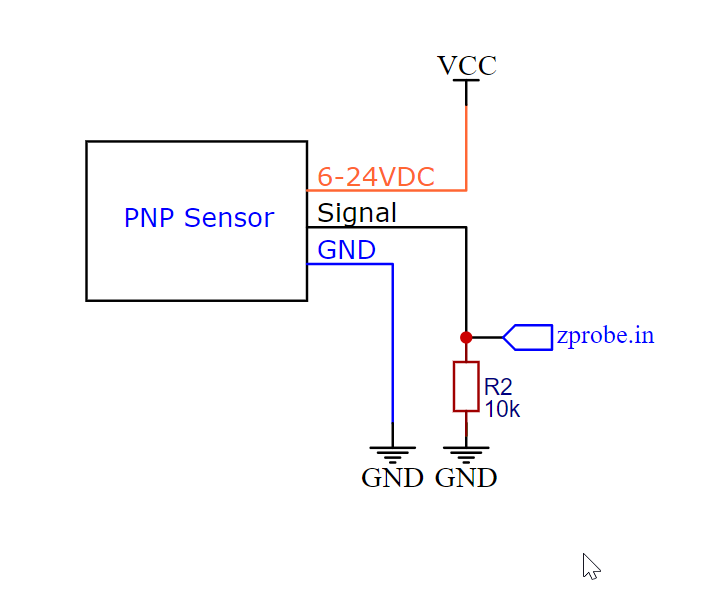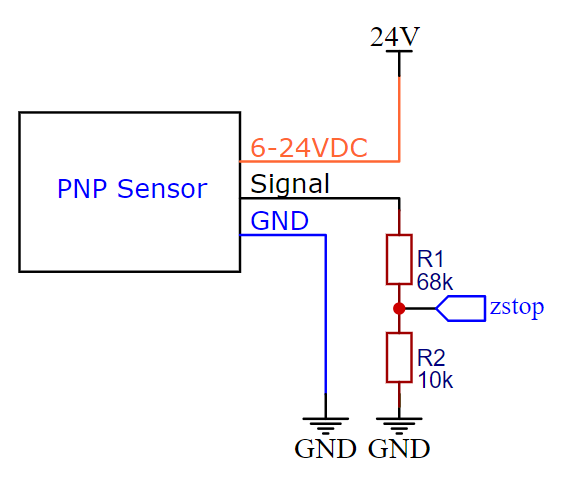PNP inductive not properly working
-
Hi! I just connected a common LJ18A3-8-Z-BY PNP inductive sensor to my delta duetWifi 1.04 controlled: I added R1 and R2 resistors as explained in the guide, but I used 100K and 275K resistors since I haven't 10K and 30K now with me.
I plugged
blue --> Duet GND in Power In connector
black --> on Z_probe_IN, and R1 and R2 between
brown --> Vin 12V in Power In connectorWhen I turn on and pass some metal under sensor, onboard led turns on.
When I look at Setting --> Machine Properties: endstops triggers well by hand, from "no" to "yes", inductive sensor doesn't trigger even if onboard led turns on and stays "yes" all the time, so G30 doesn't work, obviously.What's wrong?
Too big resistors, so not enough current?
I upload my config.g in case it could help
0_1549107585880_config.g
I used
M558 P5 H4 F120 T3000 -
One more thing:
measuring voltage between Black wire (sensor output) and GND
gives
1.32V when not triggered by metal, and led is off
3.27V when triggered by metal, and led is on -
I think the resistor values are too high. When in digital mode, the Z probe input has a pullup resistor, nominally 100K but minimum 50K. It might work if you put it in analog mode (P1 in the M558 command).
-
Sound strange, just verified: if I connect sensor to 12V external power supply I measure 0V when not triggered, 3.3V when triggered between signal (black wire) and GND (blue wire).
Will have a try on M558 P1
-
You are right: lowering resistors to 10k and 34k (two 68k resistors in parallel) the inductive PNP NO sensor works as expected, digitally, setting M558 P5.
FYI: it worked in analog mode too, with previous resistors and setting M558 P1
-
One more question: why does it work with lower resistor and not with higher ones? I would like to understand, anyone can share a simple scheme or drawing? I'm not so expert in electronics...
-
Because the internal pullup resistor (nominally 100K) is pulling the input up to +3.3V, so the value of your pulldown resistor to ground needs to be a lot lower than that, in order to hold the pin close to ground potential when your sensor is not triggered. In analog mode (M558 P1), the pullup resistor is turned off.
-
@supermarioprof I'm about to do the same install. would you be able to share your schematic as I just want to physically see the schematic and double check everything is correct. Don't really want to blow up my duet. thanks
-
@pedro-schmidt It's described here https://duet3d.dozuki.com/Wiki/Connecting_a_Z_probe#Section_PNP_output_normally_open_inductive_or_capacitive_sensor but there's no wiring diagram.
Ian
-
@droftarts thanks, i got to that page as well. the above diagram for the NPN there is only one resistor in there. would that be the same for the PNP? thanks again
-
@pedro-schmidt said in PNP inductive not properly working:
@droftarts thanks, i got to that page as well. the above diagram for the NPN there is only one resistor in there. would that be the same for the PNP? thanks again
FYI i'm running the duet 2 wifi 3.1
-
@pedro-schmidt said in PNP inductive not properly working:
would that be the same for the PNP?
No, the sensors are different. Follow the guide for PNP. If you have a multimeter, check the output voltage before connecting it to the Duet, to avoid releasing the magic smoke.
Ian
-
@droftarts sure thing. thanks for the heads up. i'll check the output voltage when i get home. just to clarify i should have 0V when NOT triggered and 3.3V WHEN triggered? as mentioned above by @supermarioprof .
-
@pedro-schmidt I haven't tested a PNP sensor, so I'm not sure. But the voltage range should be 0V to 3.3V. Doesn't matter which way, because you can always invert the signal with '!', eg M558 P5 C"!zprobe.in" H5 F120 T3000
Note that if you have a Duet 2 Wifi, board revision v1.4 or later, the probe.in pin is 30V-tolerant, which makes the wiring easier. Just make sure you get it on the right pin, though! See the Note at the end of the guide for PNP, as you still need a pulldown resistor.
Ian
-
The PNP sensor will normally drive the output to its supply voltage when triggered (6-24v normally, maybe 5v). When not triggered the output is floating, meaning it needs a pull down resistor to have a defined state of 0v when not triggered. (The sensor can be NO or NC, but this can be inverted in configs as pointed out)

if you're going to use the endstop input, then the input is still 30V tollerant but the LEDs in prefer 8v so a voltage divider as described in the link above is a good idea. (replace R1 with 20k if using 12v)

edit forgot link to led caveat. @duet ppl pngs of various combinations here: pnp_zprobe.zip if you want to update the wiki,
-
@bearer Thanks for the diagrams, I'll add them to the wiki!
Ian
-
@bearer great stuff. i'm not stupid but i do like to see the diagram. its very clear now. thanks to everyone. i'll update you later on, hopefully with a successful install. cheers
-
@pedro-schmidt said in PNP inductive not properly working:
@bearer great stuff. i'm not stupid but i do like to see the diagram. its very clear now. thanks to everyone. i'll update you later on, hopefully with a successful install. cheers
no worries; people are different - i.e I've always preferred listening to reading/watching (and with Ian adding one to the wiki maybe the next guy finds it easier as well)
the most important part with those sensors are making sure it does what it says on the tin, especially if the lower end sensors from amazon/ebay/etc. incorrect marking/ colour coding or defective units do occur. luckily the duet with its 30v tolerant inputs are more rugged than most boards though.